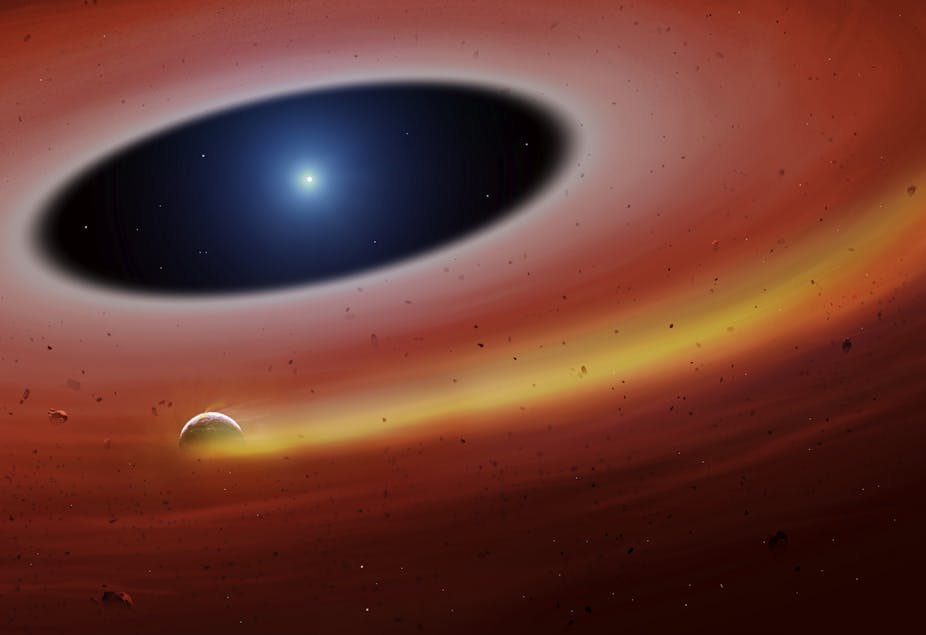If it weren’t for the sun constantly showering us with energy, there would be no life on Earth. But eventually stars like it run out of fuel, expand into red giants and finally collapse into small, faint objects called white dwarfs. So what will happen to us and the other planets in our solar system when the sun dies? It’s not been entirely clear.
Now my colleagues and I have spotted the possible core remnant of a planet orbiting the white dwarf SDSSJ122859.93+104032.9, residing some 410 light years away. Our results, published in Science, offer important clues about the fate of the planets in our own solar system.
Scientists have identified thousands of “exoplanets” orbiting stars other than the sun, many of them very similar to our own. They can do this by measuring the small movement a star makes as it responds to the gravitational tug of an orbiting planet. They have also discovered discs of gas and debris surrounding white dwarfs, but only one case of a planetary fragment. The reason such remnants are so hard to spot is that they are so tiny that they have a very small gravitational pull on their parent star.
We came up with a completely new approach to probe the gas around white dwarfs. The technique, called spectroscopy, splits the light we see from an object into its separate colours, producing a spectrum in a similar way to a prism. The observations were made using the Gran Telescopio Canarias – the largest telescope in the world with a 10.4-metre diameter mirror.

The planetary fragment we found produced a stream of gas that could be detected by our spectrometer. We could spot it orbiting the star by looking at how its spectrum shifted in colour as the body moved towards and away from us. This change in colour is called a doppler shift, which is essentially a stretching or squashing of waves because of motion. It is similar to the pitch of the sound of an ambulance being higher when it is coming towards you, and lower when it is moving away.
The body completed one passage around its host star in just over two hours, orbiting at a distance that is smaller than the radius of the sun in a disc of gas and dust.
Mystery body
The discovery is surprising, as we didn’t think anything could survive so close to a white dwarf. A white dwarf is only about the size of the Earth but it contains around 60-70% of the sun’s mass – making it extremely dense. If a body orbits too close to a white dwarf, its immense gravity will tear it apart. This was the fate of the material that formed the disc around it.
So how did it survive without getting ripped apart? It would have to be very dense or have some amount of internal strength holding it together. We calculated that it would have a maximum diameter of 720km, which is the size of a small minor planet. To compare, the dwarf planet Ceres in our own solar system has a diameter of 946km.
The origin of this body remains a mystery. One possibility is that this is the core of a minor planet that was pushed close to the white dwarf by a larger planet further out in the remnant planetary system – like a Jupiter. As the minor planet passed close to the white dwarf, its crust and mantle layers would have been ripped apart.
All that would be left of the body would be its dense, iron-dominated core. This kind of object is quite common, with one famous resident in our own solar system: the asteroid 16-Psyche.
The end of Earth?
Systems such as the one we’ve just discovered can help us understand the future of our own planetary system. In about five billion years, the sun will eventually start to expand into a red giant. At this point, it will engulf Mercury, Venus and most likely Earth – unless we manage to move our planet into a wider orbit, which should be possible in theory. However, Mars, the asteroid belt and the rest of the solar system will survive engulfment and continue orbiting it as the sun collapses into a white dwarf.
During this process, planets like Jupiter could also scatter asteroids, comets or even minor planets towards the white dwarf. There they would undergo partial or complete disruption, forming a disc like the one we’ve just investigated. It is unlikely that any living organisms on planetary or moon fragments could survive this process. And even if they did, they would struggle to live on in the faint light of a white dwarf.
This is not only the solar system’s fate, but that of practically all known exoplanet systems. In the much much closer future, we hope to use the method we have developed here to find more planetary bodies around other white dwarfs. We know of six candidate white dwarfs that are orbited by discs made of dust and gas, and we want to test whether these discs are the “smoking gun” for the presence of minor planets. The more such planets we find, the more we can learn about what happens to a planetary system as its star dies.
But our technique could also help us discover more about the composition of exoplanets – something that is extremely hard to do with exoplanets orbiting stars like our sun. The atmosphere of a standard white dwarf is very pure, made of either hydrogen or helium. But while it is consuming planetary material, its atmosphere gets polluted – enabling us to calculate how much of each element there is. This could tell us what the disintegrating planet was made of and even if it had water, helping us to build a better picture of what kind of exoplanets are the most likely to host life.

